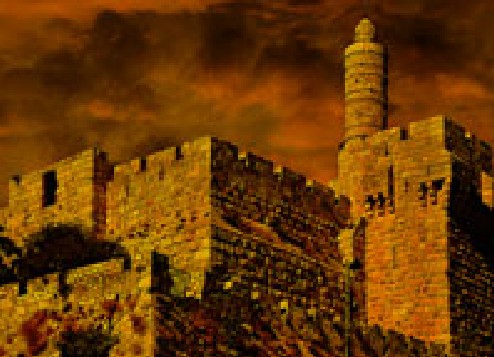Did Archaeologists Discover King David's Palace?
Occasionally, an archaeological discovery captivates the imagination of the public in Israel and the Western world, especially when linked to ancient biblical times.

Occasionally, an archaeological discovery captivates the imagination of the public in Israel and the Western world, especially when linked to ancient biblical times. Interest skyrockets when such a find might connect to Israel's earliest period of monarchy, specifically to the era of King David. Such a discovery grabbed headlines in Israel during the summer of 2005. In an excavation at the City of David in Jerusalem, a massive stone structure was unearthed, prompting the lead archaeologist to title her article on the findings with the suggestive question: Have we discovered King David's palace? Media outlets were quick to contact renowned researchers for their opinions.
As is often the case in our region concerning the sensitive subject of biblical archaeology, reactions ranged from expressions of appreciation to cautious skepticism, even outright dismissal. Dr. Eilat Mazar conducted the excavation on behalf of the Shalem Center, with support from the Hebrew University of Jerusalem, in collaboration with the Israel Antiquities Authority, Nature and Parks Authority, and the Israel Exploration Society. The Elad Association, focused on developing the City of David area, actively participated. The primary funding for the excavation came from Roger Hertog, a Jewish-American who owns the New York Sun newspaper.
From the article's title and its content, it's evident that Dr. Mazar approached her conclusions with scientific caution, placing a question mark over her findings. Her conclusions are based on archaeological findings from famed archaeologist Kathleen Kenyon in the 1960s, held near the new excavation site, the city's topography and development characteristics, and biblical texts, including the verse, "Hiram king of Tyre sent envoys to David, along with cedar logs and carpenters and stone masons, and they built a palace for David."
Dr. Mazar begins her article by referencing another she published a decade earlier in the Biblical Archaeology Review (January-February 1997 issue), where she first proposed her hypothesis regarding the potential location of King David's palace, precisely where her current excavation took place. Despite her staunch belief in her hypothesis, digging near the summit of the City of David was a significant gamble since this area had already been excavated previously (by Macalister and Duncan in 1923/25). However, previous excavators encountered large stone collapses covering the entire area and decided against removing them due to the enormous effort required, except in limited spots they dug down to the bedrock, presuming it consisted of the ruins of the Jebusite city's wall, destroyed by David upon its conquest. In the new excavation, the large stone collapses were removed, revealing the lower courses of a large stone structure whose full dimensions have yet to be determined.
The Findings
Evidence of the earliest activity at the excavation site consists of rock-cut pits, likely from the Chalcolithic period (3500-4500 BCE). Later, the rock surface was leveled by quarrying and filling pits and cracks with crushed limestone, creating a wide and level surface whose purpose and use remain unclear at this stage. On this leveled surface, a soil layer containing a large amount of animal bones and pottery sherds was uncovered, which Dr. Mazar dates to the 11th-12th centuries BCE. Above this layer, the large stone structure was found. Over this structure, remains of buildings from the Second Temple period and above both, Byzantine construction, mostly exposed in the past, were discovered. The inner walls of the large stone structure are monumental, with widths ranging from approximately 2.00 to 2.60 meters.

At the eastern edge of the excavated area, the wall survived to a height of sixty courses, about 2.50 meters. The longest wall exposed measures about 30 meters and extends into the earth at the excavation site's western edge. The soil fill within the walls' core contained pottery from the 11th century BCE. Inside the structure, walls believed by Dr. Mazar to be internal modifications to the building aimed at reinforcing first-phase walls enclose an area where nearly intact ceramics dating to the 9th-10th centuries BCE were found.
Finds that may indicate the end of use of the structure include pottery from the 7th-3rd centuries BCE discovered at the northeast edge of the excavation. Additionally, a 'bulla' (a piece of clay with a seal impression) bearing the name Yehuchal son of Shelemiyahu son of Shevi in ancient Hebrew script was found. Yehuchal son of Shelemiyahu was an official in King Zedekiah's government and was sent to the prophet Jeremiah to ask him to pray for the city under siege by the Babylonians. Later, Yehuchal and other officials demanded Jeremiah's execution, claiming his prophecies demoralized the people besieged. The eastern wall of the large stone structure was built on a cliff face bearing quarrying marks still visible.
At the base of the 7-meter-high cliff, Kathleen Kenyon previously unearthed (in the 1960s) hewn stones and a proto-Ionic (pre-Greek) column capital amidst debris. Dr. Mazar suggests associating the stones and capital with the newly discovered stone structure. If the structure is indeed a palace or a public building of similar importance, the association would be fitting. Additionally, Dr. Mazar proposes that retaining walls in the stepped stone structure excavation by Yigal Shiloh in Area G below the large stone structure's slope were intended to support the latter. Somewhat unusually, there's broad agreement among scholars on these points. The dispute concerns the dating of the structures.
Conclusions, Findings, and Hypotheses
Dr. Mazar's excavation concluded in August 2005, though the artifacts' analysis will continue for some time. The data summary related to the large stone structure suggests it is a monumental public building, likely constructed by Phoenician builders near the City of David's summit after the 11th-12th centuries BCE on leveled ground (bedrock) that previously lacked construction. Two stages of modifications or additions within the building, dated to the 9th-10th centuries BCE, have been identified, suggesting its initial construction took place at the latest in the 10th century. The building was likely in use until the end of the First Temple period. According to the researcher, its location outside of the Jebusite city walls aligns well with David's intentions to expand the city's territory.
Identifying it as a palace that served the Davidic dynasty's kings for about 400 years until the First Temple destruction aligns with the pottery and seal impressions of an official in Zedekiah's government, in whose time the destruction occurred. It's crucial to remember that when the large stone structure was built, the Temple Mount complex towering above it today did not exist. Therefore, the stone structure was built, likely at the hill's summit as it appeared then, or very close to it. This point fits with the biblical account that after David's coronation in Jerusalem, the Philistines gathered in the Valley of Rephaim, and David "went down to the stronghold." Thus, it seems likely that his palace was at the highest location in the vicinity. This was one of Dr. Mazar's primary assumptions a decade ago.
Professional Dispute
Can we definitively say King David's palace has been discovered? The probability is high, but at this time there's no absolute certainty. Dr. Mazar did not find a plaque reading "King David lived here." However, it's clear that the researcher's conclusions are based on plausible likelihoods from biblical descriptions, the material evidence, and the topographical surroundings. Is this unusual in archaeological-historical research? Certainly not. As of now, no alternative explanations for the set of data have been proposed. In interpreting biblical period finds, a fundamental and ongoing dispute among scholars is based on the dating of the finds. Most researchers generally accept that the Bible accurately describes the realities to which it refers.
As an example, researchers often use biblical quotations. However, some schools of thought argue otherwise, interpreting the relevant finds differently. From a research methodology perspective, the core of the disagreement is based on interpreting pottery as the primary chronological tool for dating built remains. In our case, the dating differences reflect a discrepancy of roughly one hundred years, but this difference forms the foundation for the historical perspective of scholars on both sides of the academic fence.
Simply put, if monumental construction in Jerusalem can be attributed to the era of David and Solomon, as described in the Bible, then the biblical account is accurate, with wide-reaching implications. Alternatively, if such construction can't be attributed to the early monarchy, the biblical descriptions are inaccurate, and thus the entire historical narrative appears differently. As noted above, what determines who's right are pottery artifacts dated differently by each school of thought. According to the view delaying the period of the structure revealed by Dr. Mazar, pottery from the 9th century BCE found in the fill beneath the walls suggests the building is later than David and Solomon's time. Conversely, Dr. Mazar argues that pottery attributed to the 9th century was found within the building but not beneath its foundations. The pottery found beneath the building's walls, she dates to the 11th century at the latest. We cannot, of course, delve into the depths of this dispute.
Methodology on Trial
The findings described so far have far-reaching implications. A foundational argument of the school denying the historical veracity of the Bible's descriptions is their belief that archaeological evidence of state construction from the monarchy's inception—specifically the era of David and Solomon—is lacking. However, here, even if it's not King David's palace, the mere existence of a monumental public building from the 9th-10th centuries BCE in this location directly contradicts viewpoints suggesting David and Solomon were merely local chieftains and that the biblical description of their kingdom's grandeur is a fabrication created for political-historical needs at the end of the First Temple period.
In contrast to the methodologies of other, more precise fields of scientific research, biblical period archaeology has a notable degree of freedom in interpreting findings. The ongoing dispute created two worldviews regarding history's depiction in this part of the globe. Each new find is placed within each side's current perspective. Resolving the different approaches might only be possible with unequivocal and uncontested findings. However, the critical question right now is whether such conclusive solutions are even possible. Perceptions of the past influence the present and the future. Heavy questions regarding culture, religion, society, and politics are discussed in every historical debate.
Archaeology plays a significant role in this discourse. Will archaeology be able to provide clearer answers? In this case, as in others, scientific skepticism is a vital part of the research process. However, now that the discovery has been made and an explanation covering all known data has been provided, merely dismissing the researcher's conclusions is insufficient. The burden of presenting an alternative explanation, which includes all the excavation findings, rests with the skeptics.

